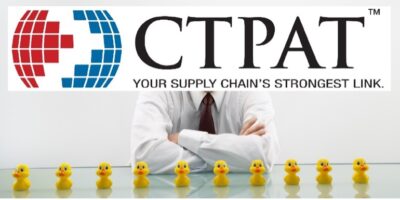Navigating the Hurdles: Challenges of Conducting an Annual CTPAT Security Review
By Judy Davis, Senior Trade Advisor, Braumiller Consulting Group
The Customs-Trade Partnership Against Terrorism (CTPAT) program can offer a fast thoroughfare for international trade. But navigating the annual security audits that ensure CTPAT compliance can feel like a maze. Don’t worry, we’ve got you covered! Let’s explore some common hurdles faced during CTPAT security audits, along with practical tips to simplify the process.
Challenge 1: Scope Creep and Resource Strain
CTPAT security criteria encompass a wide range of areas, according to the published Minimum Security Criteria (MSC). These areas include physical access security, personnel security, information and cybersecurity, and conveyance and supply chain security measures. A comprehensive audit can be a time-consuming and resource-intensive undertaking. Without clearly defined objectives and scope there will be a struggle to focus the audit effectively, which can lead to incomplete or inaccurate results. Additionally, companies often face limited resources or expertise along with budget constraints to support such a wide-ranging audit process.
- Tips:
– Established clear objectives. Take the time to develop a detailed audit plan that outlines tasks, responsibilities and required resources. Various itemized audit plan templates are available online for ideas on how to build this plan. Once established it will be a valuable resource for all future audits and actioned improvements.
– Prioritize areas based on risk assessments. Focus first on areas with the highest potential impact for security breaches. The audit does not have to be completed all at once. Spread out the budget and capture specific areas. You can use checklists and templates aligned with security guidelines to streamline the process.
– Allocate resources. Skilled personnel is only one resource. Leverage digital tools and online resources like audit software, pre-defined checklists, and other tech solutions to streamline your security audits. Consider outsourcing specific areas of the audit to external consultants.
Challenge 2: Data Gathering and Documentation
Maintaining accurate and up-to-date security documentation is crucial. A successful audit hinges on readily available and accurate documentation. Companies must ensure all CTPAT related policies, procedures, training records, and risk assessments are up-to-date, easily accessible, and align with current practices. Discrepancies between documented procedures and actual operations can raise red flags during a validation review.
- Tips:
– Implement a process whereby all supply chain documents related to CTPAT criteria are digitized at time of handling. Many will already be transmitted via an electronic system, others like transportation manifests, conveyance inspection forms, and access identification or verification might need to be converted.
– Process & Procedures documents for individual criteria should be established in a CTPAT Security Manual. This manual serves as a single point of reference for all security profile portal uploads and validation audits. Supporting documents specific to procedures should be linked to the relevant security area within the manual. For example, monthly or quarterly camera inspection forms would be linked to the Physical Access Controls section, and data from penetration testing would be linked to the Cybersecurity controls section.
– Ditch documentation chasing. Implement a centralized system for all CTPAT and audit documents. Sounds daunting, but it is actually quite simple. The digital hub eliminates the need for physical copies and allows simplified and controlled access for those involved in the audit process. Just a few clicks, and relevant personnel can readily retrieve the latest security policies, procedures, and control measures. Having everything organized in one place is key to a smooth and efficient validation or re-validation meeting.
Challenge 3: Employee Cooperation and Overcoming Resistance
The success of a CTPAT security program hinges on employee buy-in, but implementing the recommended changes to solve identified vulnerabilities can be an uphill climb. Those accustomed to established processes, technologies, or policies may resist new procedures. This resistance can create a gap between the identified weakness and a stronger security position.
Tips:
Uncover the root causes of resistance: Often, resistance stems from a fear of the unfamiliar. New procedures can feel overwhelming, and employees might worry about how new processes will impact their workflow. Address these concerns directly. Anticipate pushback due to potential disruption. Change can be inconvenient, and some might question its necessity. Be prepared to counter the negative, “if it ain’t broke, don’t fix it” mentality with positive approaches to benefits, ease of process, and overall security.
– Strategize for Change. Involve the boots-on-the-ground people in the planning and decision-making process for how to implement the changes. This will not only address concerns but will build ownership over the new procedure. Then, provide training and on-going support to ease the transition. Peer to peer training, or OJT is usually well received and has the lowest level of impact on workflow.
Challenge 4: Closing the Loop
Security is an ongoing process, not a one-time event. You must close the loop on the audit and still maintain a level of cooperation for continued success.
- Tips:
– Compile an internal Audit report outlining the observations and recommendations. Establish the potential impact and the consequences if vulnerabilities are not addressed. Determine actionable steps and practical recommendations for strengthening the company’s security posture.
– Establish a system for monitoring and tracking progress for the implementation of all new processes or recommendations. Remember, it’s a collaborative effort, so work alongside and encourage participation in new development. This will help put everyone on the same page.
– Build a Culture of Security for the Supply Chain. Frame the audit as a springboard for improvements that motivates the “Worker Smarter” refrain. Support regular small group or departmental meetings to keep people engaged and formulate a path for improvement suggestions. Employees at all levels need to be aware of emerging threats and how they should be addressed.
Embrace the annual CTPAT review as a valuable tool for identifying and addressing vulnerabilities and building smart work habits. By collaborative efforts and focus on continuous improvement, you can turn challenges into a strong security posture that safeguards your business and its reputation.
Read more articles by Judy: https://www.braumillerconsulting.com/author/judy-davis/

























